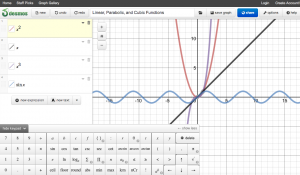Modeling a Digital and Global age Learning Environment
Brittany Moore
Bolded words are linked to sites!
Technology is even more present in our world than ever, and a very large part of our students’ daily lives and in how they see and interpret the world around them, so it only makes sense that it is incorporated into their standard learning regimen.
Web 2.0 refers to the new stage in development in the World Wide Web that allows users to interact with webpages rather than just use them as a source of information. This is a wonderful opportunity for teachers and should be taken advantage of.
There are many new ways for teachers to connect and share ideas, which they can use to create new lessons and gain new teaching strategies or to find ideas to supplement their already tried and true methods. Teachers may also find this helpful to help students who are struggling and not grasping the concept the way the teacher is teaching it. Many teachers think of Pinterest  when they think of turning to the internet to find creative lesson ideas, but would you have thought to look at Scholastic for interactive math lesson ideas? They even have some awesome tips for integrating technology into your classroom.
when they think of turning to the internet to find creative lesson ideas, but would you have thought to look at Scholastic for interactive math lesson ideas? They even have some awesome tips for integrating technology into your classroom.
You have used technology find ways to enhance your lesson, now how can you present this information to your students in a way that uses the technology to make it fun and interesting? Rather than standing at the front of the room lecturing, one go to form of presentation is the Prezi, an interactive slideshow presentation that is customizable to your presentation. Now, a slideshow presentation may seem like a difficult or dull way to learn math, but this Prezi about the number system provides an amazing visual for students.
https://prezi.com/n-8ibkiw881r/number-systems/
Prezi can be accessed for free, but creating a free presentation allows Prezi to add it to their database for other users to search and view or use, which can also be a helpful way for teachers to find new ideas or ways to present topics. This could be an example to students about how to be responsible about what they post because once it’s online it stays online forever, and also to discussions about plagiarism the consequences of taking someone else’s work to pass it as your own.
Other sites that can be extremely helpful, Desmos Graphing Calculator is not only an extremely useful resource for students, it also has pre-programmed examples under the tab on the left side and allows sliders to be able to plug in variables into generalized formulas.

This could be used as a modeling exercise during instruction. A teacher could even project the graph or lines up onto the whiteboard and mark points or lines on the perfectly projected graph rather than having to draw the axis and try to guess while plotting points, this will make it easier for students to see exactly where points are. This is also a helpful resource for students when they are at home they can access the examples. Desmos is also available as an app on all devices and could be used as a support or accommodation for students who may have difficulties with fine motor function and are unable to graph on paper.
One way that utilizes technology and makes assessment fun for students is Kahoot!, a survey type quiz program that allows students to use their phones or computers to answer questions projected onto the board. Students receive points for their answers correctness and then the speed of their answer. This can be a fun formative assessment as well self assessment for teachers and students to gauge the students’ understanding of the topic and determine what materials need more focus or review.
